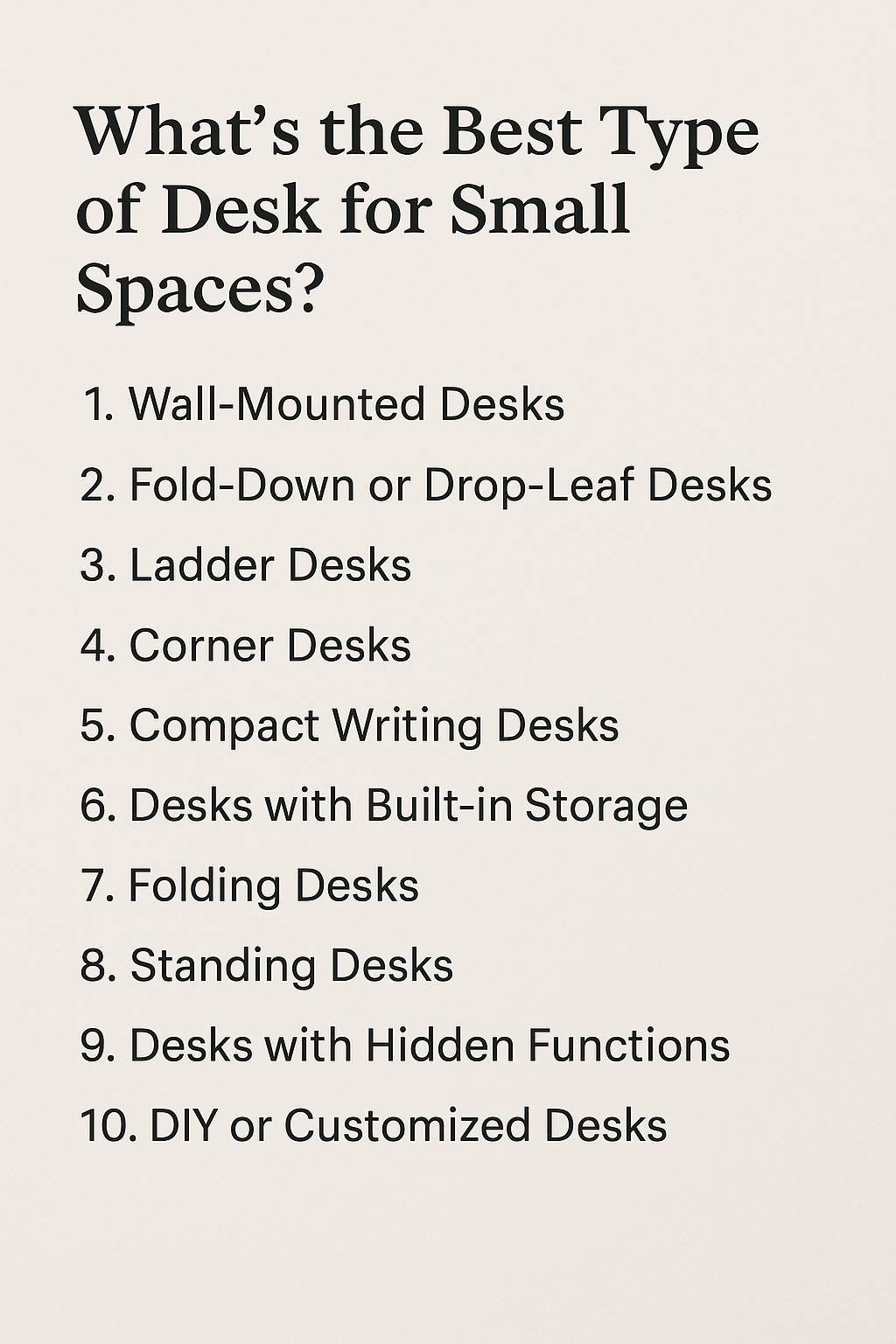When space is limited, every furniture piece in your home must serve a purpose—and do it efficiently. The desk is no exception. Whether you’re setting up a permanent home office, a temporary remote workstation, or a study corner in your small apartment, choosing the right type of desk can make all the difference.
This comprehensive guide will explore the best desk options for small spaces, considering size, functionality, style, storage, and flexibility.
Why Your Desk Choice Matters in Tight Quarters
In small homes or apartments, the wrong desk can:
- Make a room feel cramped
- Block natural light or foot traffic
- Lead to clutter due to lack of storage
- Be uncomfortable or ergonomically poor
Choosing a compact, efficient desk design not only saves space—it can enhance your productivity, reduce stress, and even improve your posture.
1. Wall-Mounted Desks (Floating Desks)Best for: Ultra-tight areas, modern aesthetics, multi-use rooms
What it is: A shelf-like surface attached directly to the wall, sometimes foldable or featuring small drawers.
Pros:
- Takes up zero floor space
- Minimalist and sleek
- Can be installed at any height
- Can double as a console or vanity
Cons:
- Requires installation (not ideal for renters unless using removable brackets)
- Limited workspace
Ideal locations: Bedroom nook, hallway, or near a window
2. Fold-Down or Drop-Leaf Desks
Best for: Flexibility and multi-use spaces
What it is: A desk that folds out when needed and tucks away when not in use. Some resemble wall-mounted cabinets or drop-leaf tables.
Pros:
- Saves space when not in use
- Can be wall-mounted or freestanding
- Some models offer hidden storage
Cons:
- May feel less stable than fixed desks
- Smaller surface area
Pro tip: Look for models with a built-in board, shelves, or cord management.
3. Ladder Desks (Leaning Desks)Best for: Style-conscious renters, vertical storage needs
What it is: A vertical, freestanding structure with a small desk surface and tiered shelves above it, leaning against the wall.
Pros:
- Combines workspace and storage
- No installation needed
- Visually light and airy
Cons:
- Desk surface is often shallow
- Not suitable for large monitors or multiple devices
Bonus: Can be styled as a decorative bookshelf when not in use.
4. Corner Desks
Best for: Making use of awkward corners or unused nooks
What it is: A desk designed to fit snugly into a 90-degree angle, maximizing corner real estate.
Pros:
- Makes use of dead space
- Offers decent surface area
- Some models include drawers or shelves
Cons:
- Not easily movable
- Can block access to wall outlets or vents
Tip: Choose an L-shaped design for dual monitors or to divide work vs. leisure space.
5. Compact Writing Desks
Best for: Minimalists and laptop users
What it is: A simple desk with a flat surface, often with slim legs and minimal storage.
Pros:
- Affordable and widely available
- Lightweight and easy to move
- Fits with most décor styles
Cons:
- Little to no built-in storage
- Not suitable for heavy equipment
Style idea: Add a rolling cart or under-desk drawers for extra storage.
6. Desks with Built-in Storage
Best for: Home offices without a dedicated filing cabinet or shelves
What it is: Desks that include drawers, cubbies, or side cabinets.
Pros:
- Keeps supplies within reach
- Reduces surface clutter
- Efficient for small rooms with no separate storage
Cons:
- Often bulkier
- Heavier to move
Suggestion: Look for slim-profile models with shallow drawers that don’t dominate the room.
7. Folding Desks (Portable Desks)
Best for: Temporary or multi-functional spaces
What it is: A desk you can fold flat and tuck away when not in use.
Pros:
- Great for small or shared spaces
- Perfect for renters or students
- Often lightweight and budget-friendly
Cons:
- Not ideal for heavy or permanent setups
- Minimal storage and surface area
Use case: Set up in the morning, store away at night. Perfect for dual-use living rooms.
8. Standing Desks (Compact or Adjustable Models)
Best for: Health-conscious users and shared workspaces
What it is: Desks with adjustable height to alternate between sitting and standing.
Pros:
- Promotes movement and posture variety
- Adjustable models fit multiple users
- Some models fold or roll
Cons:
- More expensive
- Can be bulky if not chosen carefully
Look for: Narrow-profile standing desks or wall-mounted versions to save floor space.
9. Desks with Hidden Functions (Convertible or Multifunctional)
Best for: Multi-use furniture lovers
What it is: Desks that double as something else—like a dresser, bookshelf, or dining table.
Pros:
- Saves money and space
- Great for studio apartments
- Adds surprise value and flexibility
Cons:
- May require creative organization
- Not always comfortable for long hours
Examples:
- Desk-dining table combos
- Murphy beds with fold-down desks
- Desks hidden behind cabinet doors
10. DIY or Customized Desks
Best for: Unique spaces or budget-friendly solutions
What it is: Creating a desk using reclaimed wood, floating shelves, IKEA hacks, or made-to-fit surfaces.
Pros:
- Fully tailored to your space
- Budget-friendly
- Adds a personal touch
Cons:
- Requires tools and effort
- May lack the polish of store-bought pieces
Ideas:
- Use a shelf and brackets to create a budget floating desk
- Repurpose a console table as a workspace
- Turn an old sewing table or vanity into a chic desk
How to Choose the Right Desk for You When picking your desk, consider:
- Available space: Measure before buying!
- Usage: Laptop only or monitor, printer, books, etc.?
- Storage needs
- Style preferences
- Mobility: Will it move often or stay in one place?
- Budget
The best desk for a small space is the one that fits your needs, space, and style—not necessarily the one with the most features. Whether you choose a floating shelf-style desk, a rolling workstation, or a slim writing table, the key is balancing functionality with design and spatial efficiency.
With so many compact and creative options available today, you no longer have to compromise productivity just because you’re working with a few square meters. A small desk with the right features can completely transform your space—and how you feel about working in it.

